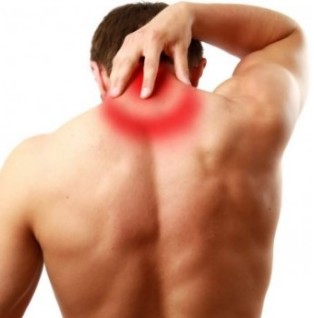Osteochondrosis – a disease of the spine, which is characterized by the development of changes to the skin of the intervertebral disc and reactive processes in the surrounding tissues.
Cervical osteochondrosis of the spine is different in its manifestations from the thoracic and lumbar degenerative disc disease. Symptoms of cervical degenerative disc disease are associated with anatomical features of the cervical spine. The dimensions of the vertebrae of the neck the smaller the size of the other departments. The cervical department is constantly experiencing burden, holding my head and while it differs a great ability of movement and orientation.

Causes of degenerative disc disease
The reasons for the development of the disease in the first place, are caused by age aging and development destruction of bone and cartilage. Also, you can call the following causes of degenerative disc disease:
- violation of posture,
- reduction of physical activity due to sedentary way of life,
- overweight, which is a consequence of metabolic disorders, has the load on the intervertebral discs,
- the hereditary factor,
- long-term physical load,
- anomalies of the spine.
Consistent exercise, proper nutrition and a healthy lifestyle greatly reduce the likelihood of developing this disease, but also reduce the impact on the overall health.
Symptoms of cervical degenerative disc disease of the spine
Manifestations of cervical degenerative disc disease are different from symptoms in other parts of the spine. It has to do with the fact that the neck vertebrae have a different structure and are located very close. So any shift is manifested severe pain. In addition, in the cervical region of the spine is often zaselyalsya nervous bundle and blood vessels.
Cervical osteochondrosis spine is manifested by the following symptoms:
- The feeling of pain – the pain can felt in different parts of the body. It has to do with what is going pinched nerve endings and the muscles of the relevant part of the body.
- Weakness in the upper extremities – is manifested due to the pinch points of the nerve endings that are responsible for physical activity.
- The complexity of when turning the head, the emergence of the crunch of the vertebrae in the cervical region – arise due to changes in the structure of the intervertebral discs, formation of bone formations.
- The low sensitivity of the hands.
- Weakness and dizziness occurs due to the pinch points of the artery which provides blood flow and nutrition in the brain.
- Hearing loss and vision – appear at the last stage of the disease, when the blood circulation is disturbed in the cerebellum.
Symptoms of cervical degenerative disc disease
- Root syndrome – characterized by a pinched nerve bundle in the neck area. Is manifested by severe pain, which can feel in the shoulders, my shoulder.
- Vertebral syndrome – manifested with established headaches, pain in the temples and the nape of the neck.
- Reflex syndrome – is characterized by severe pain in the cervical region, which may confirm in every movement of the head. The pain may move in the shoulder and chest.
- Cardinal syndrome – feels like a heart attack, angina pectoris, to determine which is extremely difficult.
The degree of development of cervical degenerative disc disease of the spine
In his development of the disease goes through several stages. Each stage has its own characteristics, and is characterized by certain symptoms.
- 1 phase. Musculoskeletal cartilage tissue of the vertebrae is gradually starting to crumble. The symptoms of the disease are few visible. And very often the sick is simply do not perceive, and combine fatigue and pain with fatigue and stress.
- 2 phase. At the height of the disc begins to decrease and is on it cracks. The patient is experiencing constant pain, weakness, numbness of the face.
- 3 phase. Begin to form, herniated discs, damaged neck vessels and muscles. Appear to complaints of dizziness, pain in the neck.
- 4 phase. Bone tissue that protects the vertebrae from excess load, begins to grow, thereby zaselyalsya nerve endings. Occurs stiffness in the movements, vandalized as well as the neighboring joints.
The danger of cervical degenerative disc disease
In the cervical region there is a large amount of nerves and blood vessels that provide food to the brain. In case of violation of their work, the brain will not have enough energy for normal functioning. This situation can impair the musculoskeletal system of human activity, induce pain in the extremities, and loss of coordination.
In the running phase, the degenerative disc disease may develop ischemia, stroke and many other diseases, dangerous to human life.
Therefore, upon the occurrence of any of the symptoms associated with this disease, it is recommended to seek medical help.
The diagnosis of the cervical spine
For an overview of diseases of the spine is used in the following types of diagnostics:
- x-ray – is an inefficient method of diagnosis of this disease,
- MRI (magnetic resonance imaging)shows the bone structure, which arise from disc herniation and their size,
- CT (computed tomography), inefficient in comparison with magnetic resonance imaging, because using this method the diagnosis is difficult to determine the dimensions of the hernia,
- Ultrasound duplex scanning is used in the case where it is disrupted the overall flow of blood. This survey shows the current speed of blood flow, but also the presence of obstacles in its path.
Treatment of cervical degenerative disc disease of the spine

Treatment of cervical degenerative disc disease the spine should be performed in the complex, depending on the situation. A positive effect can be achieved through an integrated and individual approach, which includes herbal therapy, chiropractic treatments, therapeutic physical training, massages, used as a means of folk medicine.
In the period of exacerbation treatment of cervical degenerative disc disease of the spine is focused on the improvement of blood circulation, relief from muscle cramps. In this case, are the means, which increase the flow of blood, anti-inflammatory and pain medication remedy vitamin complex.
Medical gymnastics in osteochondrosis of the cervical
Physiotherapy gives visible results and less dangerous in the stage of healing. The principle of therapeutic physical training lies in the restoration of blood flow in the damaged part of the body. The performing exercises of medical physical education the patient must not feel pain and discomfort.
Set of exercises for the cervical spine is designed to strengthen the muscles of the neck, and also acts as prevention for the development of cervical degenerative disc disease.
Massage in osteochondrosis of the cervical spine
Massage is performed with the aim to strengthen the tone in the muscles and relieve the pain. Depending on the degree of development of the disease, are the different methods of massage. In addition to the classic techniques of massage include:
- stroking – this income is in the impact on the surface layer of the skin. Starting to massage the collar area and continues to the clavicle and the armpit.
- squeezing – in this case, it is impact in the course of the massage occurs on the deeper layers of the skin. The width of the neck with the thumb and index finger perform the movement after the invasion of the skin, which resemble the squeezing.
- friction – is carried out in order to warm up and relax the skin, improve blood circulation in the neck area of the cervical spine.
- kneading – has specific restrictions, so how they act on the deep-lying tissue. In the wrong implementation of the reception may harm the patient.
In cases where the patient's sensation of pain occurs only on one side, the massage should start to perform from the healthy part of the neck, gradually moving on the part of the neck, where the pain comes.
Massage can be done both at home and in a medical facility. However, in the course of its implementation should be very careful not to provoke the exacerbation of the disease, or do not make things worse.
Prevention of cervical degenerative disc disease
To prevent the occurrence and development of disease, it is recommended to follow the simple rules:
- lead a healthy lifestyle, perform physical exercises, regularly visit the swimming pool;
- diversify the diet with foods rich magnesium, and calcium;
- in the case of a sedentary job need to several times a day to do the exercises;
- for sleep it is necessary to choose a orthopedic mattress and a comfortable pillow.
















